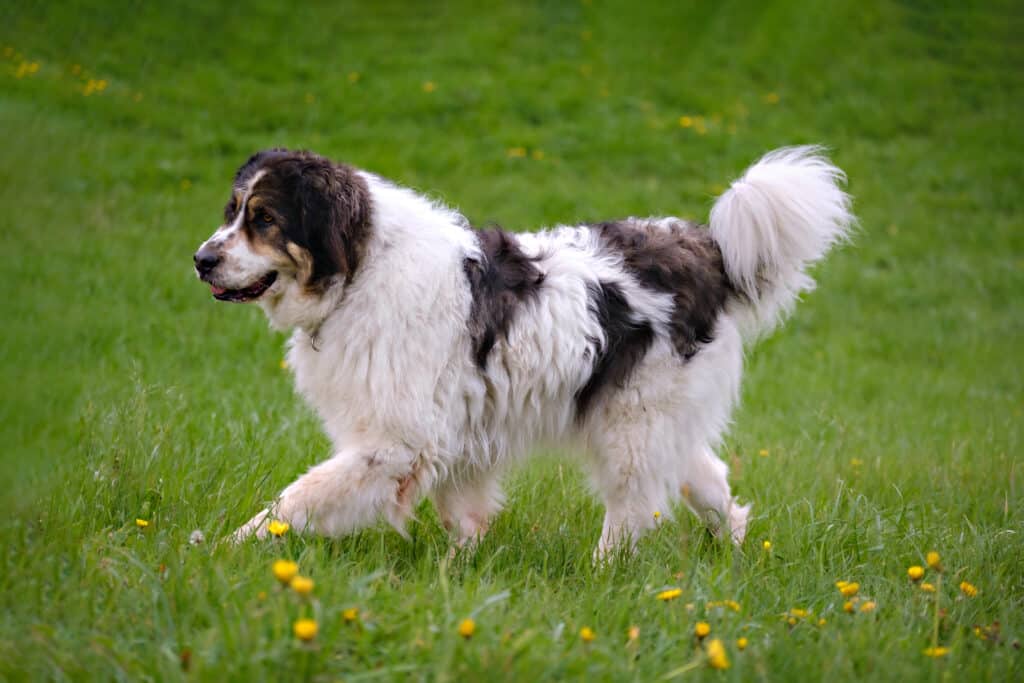Typically, domestic dogs are diurnal animals, meaning they are more active during the day and sleep at night. However, there is controversy and debate about whether dogs are nocturnal, crepuscular, or genuinely diurnal animals. Dogs may be more active during the daytime because their human companions are around. But dogs often sleep during the day too. They exhibit profound cathemeral (activity pattern at irregular intervals during the day or night) tendencies. Research sheds some light on this topic and explains their sleep behavior. So, if you’re a dog owner or just interested in learning more about them, keep reading for insights into the sleeping habits of man’s best friend.
Domesticated Dog Species

Dogs also seem to synchronize their sleeping schedule with their owners, sometimes falling asleep after an owner has gone to bed for the night.
©NiaB/Shutterstock.com
The domesticated dog has been a prized animal species throughout history. People prize dogs for their versatility, quick learning ability, and friendly nature. Adding to their love for dogs, breeders have created many different dog breeds over time. Each species has its own unique characteristics, and people often use them for various purposes.
Some of the most well-known dog species include the following:
When we think of dog breeds, the most common ones that typically come to mind are the big, fluffy Golden Retrievers and noble German Shepherds. Still, there are many other types of dogs out there with fascinating histories.
These lesser-known breeds initially derive from rarer species of canines that humans bred for specific purposes:
- The Tamaskan dog is a large breed descended from Siberian wolves. It was bred in Finland as an all-purpose working dog.
- Several species originated in Africa, such as the Basenji, which comes from the Congo.
- The Rhodesian Ridgeback is named after the African country of Rhodesia (presently known as Zimbabwe).
Each canine breed has its distinct appearance, temperament, and set of skills and abilities. So, if you consider welcoming one of these amazing animals into your home, it would be beneficial to understand their sleeping behavior.
Sleep Patterns in Domestic Dogs: Diurnal or Highly Flexible?
Dogs are well-known for their love of sleep, often spending up to 16 hours or more of each 24-hour day in some form of rest. This rest can take many forms, ranging from curled up at the side of their human owners to stretching out lazily on a cozy sofa.
Dogs also seem to synchronize their sleeping schedule with their owners, sometimes falling asleep after an owner has gone to bed for the night. However, they may also exhibit bursts of activity and sleep periods when their owner is awake. This sleep pattern can change anytime, influenced by their owners’ practices.
This social sleeping behavior may result from the close bond between dogs and humans, Or, it could simply be a consequence of instinctual mimicry. Overall, the amount and type of sleep that dogs need, varies widely from dog to dog and depends on several factors, including age, breed, activity level, and environment.
Are Phases of Sleep Cycle in Domestic Dogs Nocturnal?
Sleep is essential to maintaining domestic dogs’ overall health and well-being. To better understand their sleep cycle, it is necessary to know how the phases of sleep influence a dog’s alertness and physiological regulation.
Sleep duration and frequency are essential characteristics that help determine how much rest a dog requires. For instance, humans typically sleep in a single block each day. However, dogs engage in multiple rest periods throughout the day and night.
Regardless of structure or timing, all dogs typically experience two distinct phases of sleep: non-REM sleep and REM sleep (also known as rapid-eye movement).
Non-REM sleep (light sleep) primarily benefits the dog’s energy levels and restores various physiological functions. In contrast, REM sleep (deep sleep) helps maintain cognitive health by enhancing memory and promoting the brain’s ability to change and adapt. Given these vital roles in health and well-being, it is clear that when dogs sleep (diurnal or nocturnal cycles), appropriate amounts of quality sleep are crucial.
Can Dogs Distinguish Between Night and Day?
Yes, they can. Some people believe that dogs cannot visually distinguish between day and night. Still, recent research on this topic tells a different story. Dogs do not see precisely the same way humans do, only seeing in hues of yellow and blue and lacking our depth perception. However, they can better detect differences in light levels and use this information to their advantage.
Not only can dogs tell when it is light or dark outside, but many can also distinguish between subtle variations in brightness. They have adapted similarly to their wild cousins, with the ability to see both night and day. In addition, many dogs use other cues, such as sound and scent, which help them understand when the sun has set or risen.
Dogs Have Excellent Night Vision Due to Their Eye Structure

Dogs are diurnal but must sleep for up to 15 hours daily to maintain their health.
©Witthawat/Shutterstock.com
Many dog owners are familiar with their pets’ remarkable ability to see well in low-light conditions. From navigating the dark corners of a basement to spotting prey in thick forests, dogs consistently outperform humans when it comes to seeing in dim environments.
One reason is that dogs have tapetum lucidum (a layer of reflective cells behind the retina) that allows them to draw information from the slightest hints of light. Furthermore, they have more significant numbers of light-sensitive rods in their retinas. These rods make them capable of detecting brightness changes, allowing them to process more visual information than we can. Ultimately, it seems clear that dogs are more than just creatures of habit: they can perceive and adapt to environmental changes around them.
Species of Wild Dogs
There are currently 35 recognized species of wild dog, all of which belong to the dog family Canidae. These canids include both extinct and living species, such as wolves, foxes, and jackals.
Well-known examples of wild dog species include the following:
- Gray Wolf
- Coyote
- Red Fox
- Arctic Fox
- Kit Fox
- African Wild Dog
- Golden Jackal
More unknown and sub-species of wild dogs are:
- Arctic Fox
- Bat-eared Fox
- Bengal Fox
- Black-Backed Jackal
- Blanford’s Fox
- Bush Dog
- Cape Fox
- Corsac Fox
- Culpeo
- Darwin’s Fox
- Dhole
- Ethiopian Wolf
- Fennec Fox
- Short-Eared Dog
- Side-Striped Jackal
- South American Gray Fox
- Swift Fox
- Tibetan Sand Fox
Interestingly, the domestic dog – commonly referred to simply as a ‘dog’ – is usually considered a subspecies of the gray wolf. However, some authorities maintain that the domesticated dog should be a separate species altogether.
Whatever their taxonomic status, these fascinating animals undoubtedly deserve our admiration and conservation efforts. Whether you are an avid wildlife enthusiast or enjoy observing nature from your backyard window, there is always something new to discover about these amazing creatures.
Wild Dogs Sleep Behavior: Nocturnal, Diurnal, or Crepuscular?

Depending on the species and its geographical environment, feral dogs may be diurnal, nocturnal, or crepuscular.
©Vesna Kriznar/Shutterstock.com
Wild dogs fall into the category of carnivores, meaning they primarily feed on other animals. Depending on the species and its geographical environment, feral dogs may be diurnal, nocturnal, or crepuscular. Some experts believe wild dogs are primarily crepuscular and active during dusk and dawn. However, others have observed that wild dogs appear somewhat busy at night, especially when hunting or scavenging for food.
Studies show that some wild dog populations may adjust their activity patterns based on the temperature, becoming more nocturnal due to the day’s extreme heat. Ultimately, more studies are necessary to understand wild dogs’ behavior and activity patterns fully. Until then, it seems likely that these animals exhibit features of three sleep patterns in different contexts and situations.
Nocturnal or Diurnal Dog Take-Aways
- Wild dogs are not strictly nocturnal or diurnal. Their instincts, breed, and environment strongly influence their sleep behavior.
- Wild dogs’ instincts drive them to be active when they are most likely to find food or mates in the wild.
- Domestic dogs have adapted to human schedules and often adjust their sleep patterns accordingly.
- Domestic dogs have visual adaptions that facilitate good eyesight during the day and excellent nighttime vision.
- Adequate quantity and phases of sleep are vital for a dog’s overall well-being.
Nocturnal vs. Diurnal: What’s The Difference?
Navigate to Nocturnal vs. Diurnal: What’s The Difference? for further information about the nocturnal and diurnal phenomenon in various living creatures.
Up Next – More About Dogs
The photo featured at the top of this post is © Javier Brosch/Shutterstock.com
Ready to discover the top 10 cutest dog breeds in the entire world?
How about the fastest dogs, the largest dogs and those that are -- quite frankly -- just the kindest dogs on the planet? Each day, AZ Animals sends out lists just like this to our thousands of email subscribers. And the best part? It's FREE. Join today by entering your email below.
Sources
- Springer Nature, Available here: https://link.springer.com/article/10.1007/s00442-018-04329-1
- ScienceDirect, Available here: https://www.sciencedirect.com/science/article/pii/S2352154619301378
- National Library of Medicine, Available here: https://www.ncbi.nlm.nih.gov/pmc/articles/PMC7401528/
Thank you for reading! Have some feedback for us? Contact the AZ Animals editorial team.






